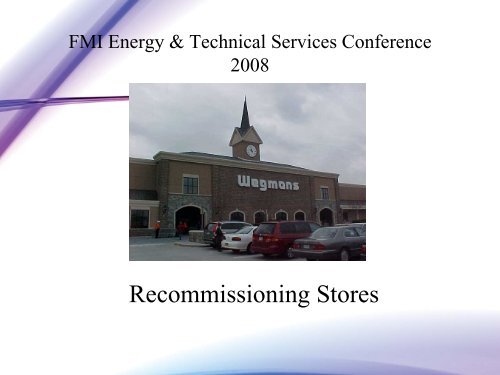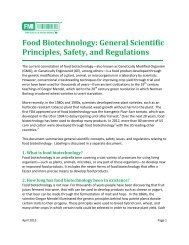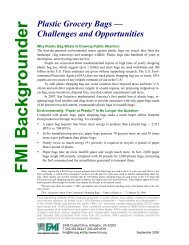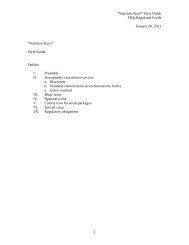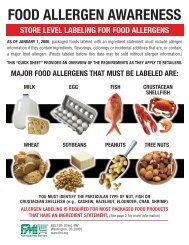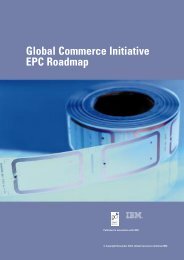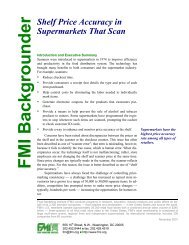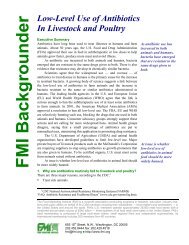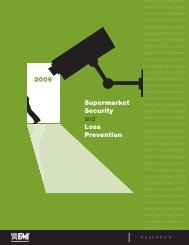Wegmans Food Markets Fairfax, Va - Food Marketing Institute
Wegmans Food Markets Fairfax, Va - Food Marketing Institute
Wegmans Food Markets Fairfax, Va - Food Marketing Institute
Create successful ePaper yourself
Turn your PDF publications into a flip-book with our unique Google optimized e-Paper software.
FMI Energy & Technical Services Conference<br />
2008<br />
Recommissioning Stores
Agenda<br />
• <strong>Wegmans</strong> store Facts and Figures<br />
• Starting and prioritizing (resources and<br />
methods)<br />
• The recommissioning sequence<br />
• What does it mean to each stakeholder?<br />
• Format
Store Facts and Figures
Store Summaries<br />
• 72 Stores, average size over<br />
100,000sf<br />
• Hours 6 a.m. to midnight, 7 days<br />
a week (many are 24 hour).<br />
• New stores 140,000 square feet,<br />
mezzanine-level seating for more<br />
than 200 in the Market Café<br />
• 600 employees per store<br />
• Forty point of sales terminals
Starting and Prioritizing
Getting Started<br />
• How we are organized<br />
• Larger set of expectations<br />
– Improving design<br />
– Improving construction/start-up<br />
– Reducing maintenance costs<br />
– Educating store personnel on importance<br />
• In house or outside resources?<br />
• Use of current vs. new contractors/consultants<br />
• Educating management on the value<br />
• Educating stakeholders on the value
Prioritizing<br />
• How to prioritize? $$$<br />
• Combination of total kwh usage and kwh<br />
unit cost<br />
• Comparing stores equipment and systems<br />
• Do you have the technology to measure the<br />
results in each store?
The Recommissioning<br />
Sequence
The First Steps<br />
• Collect and distribute drawings, details to<br />
the recommissioning agent<br />
• Meetings with Design, Maintenance and<br />
Construction - orientation<br />
• Introduction/explanation for the store<br />
• Kickoff meeting with all
Next Steps<br />
• Survey of equipment and<br />
operating practices.<br />
– If any mechanical equipment<br />
needs servicing, maintenance<br />
will be notified<br />
– If any unfavorable operational<br />
practices are observed, the<br />
store manager will be notified<br />
for correction
Next Steps<br />
• work commences – (1 to 3 weeks)<br />
– Refrigeration<br />
• Set up logging history!!!<br />
• Set point/system operation changes<br />
• Maintenance Items<br />
– Add refrigerant<br />
– Set superheats<br />
– Adjust/replace valves<br />
–Etc
Next Steps<br />
– HVAC<br />
• Set up logging history<br />
(long term)<br />
• Set point/system<br />
operation changes<br />
• Maintenance Items<br />
– Identify units that are<br />
NOT operating<br />
correctly<br />
– Add refrigerant<br />
– Set superheats<br />
– Adjust/replace valves<br />
–Etc
Next Steps<br />
• Energy Management Department verifies completed<br />
work<br />
– Project overview report<br />
– Quality assurance report<br />
– Review system operations<br />
• Project follow up meeting (month or two after<br />
completion)<br />
– Review Project data<br />
• Cost<br />
• Savings<br />
– Discuss challenges<br />
• Maintenance<br />
• Operations<br />
• Energy
Next Steps<br />
• Report back to all departments involved<br />
– Energy savings<br />
– $$ savings
• Refrigeration<br />
– Med. Temp.<br />
• Reduced glycol pump operation<br />
(from 3 to 1)<br />
• Glycol casesmanufacturing/installation<br />
problem<br />
identified<br />
• Chiller TXV problem identified?<br />
• Glycol from 20° to 22°<br />
• Suction from 10° to 14°<br />
– Low Temp Rack<br />
• floated up 1 - 3 psi<br />
• W.I. Freezer issues<br />
– Superheat<br />
– People/Operations<br />
Was it Worth It??
Was it Worth It??<br />
• HVAC<br />
– Issues Identified and Resolved<br />
• Compressors “failed”<br />
• Frost in cases<br />
• Cases sweating<br />
• Dampers fixed open<br />
– Fan motor strategy<br />
– Anti Sweat calibration strategy<br />
– Temp sensor calibration!<br />
– Redraw of the Graphics
Was it Worth It??<br />
• $avings<br />
Refrigeration<br />
Rack A Estimated Savings<br />
Rack B Estimated Savings<br />
Total kWh/day<br />
Before<br />
After<br />
Energy<br />
Savings/day<br />
Rate<br />
$ Saved/yr<br />
Total kWh/day<br />
Before<br />
After<br />
Energy<br />
Savings/day Rate $ Saved/yr<br />
2,085<br />
1,937<br />
148<br />
0.09<br />
$ 4,862<br />
3,724 3,190 534.5 0.09 $ 17,558<br />
* Savings can be attributed to changing the float strategy (including<br />
cases with w.i)<br />
and closing the freezer door as often as possible.<br />
* Rack floated up from 10° sst to 14° sst<br />
HVAC/Lighting<br />
"HVAC" Estimated Savings<br />
Total kWh/day<br />
Before<br />
After<br />
Energy<br />
Savings/da<br />
y<br />
Rate<br />
$ Saved/yr<br />
3,943<br />
3,570<br />
373<br />
0.09<br />
$ 12,254
So how did that feel???<br />
• Review of perspectives on recommissioning:<br />
–Maintenance<br />
–Design<br />
–Construction
Robert Sperl - Regional Maintenance Manager<br />
(Virginia)<br />
• Benefits<br />
– Past Experience: I’ve been a believer for years!<br />
– Cost Effective Strategy<br />
• Reduction in maintenance effort<br />
• Reduced OT calls<br />
• Project Completion<br />
– Meetings, punch lists, final walk trough, testing<br />
– Correct the problems.<br />
• Project is not complete until the problems are neutralized.
Keith Trusky - Regional Maintenance Manager<br />
(New Jersey)<br />
• How did it feel?<br />
– Coming from a technical background, I was very<br />
skeptical of significant energy savings made possible<br />
by recommissioning without sacrificing:<br />
• Product integrity<br />
• Reliability<br />
• Ease of maintenance<br />
• Commissioning Set Points (at Construction start up)
Keith Trusky - Regional Maintenance Manager<br />
(New Jersey)<br />
What did we learn?<br />
• Set point changes were made cautiously<br />
• New Perspective<br />
• Break the cycle of doing things only “because they<br />
have always been that way.”<br />
• Opportunity for Continuous Improvement:<br />
– System efficiency<br />
– Performance<br />
– Define best practices for startup<br />
– Better understand design issues<br />
– Benchmarking for service and startup quality
Rich Kelley – Mechanical Engineer - Design<br />
• The re-commissioning process was fairly painless<br />
from the design perspective. It required reviewing the<br />
design documents with the energy manager and<br />
commissioning authority so they had a clear<br />
understanding of the design.<br />
• The re-commissioning process pointed out a few<br />
areas that warrant further engineering review on<br />
system design.<br />
– Night Setback Strategy<br />
– Make-up air Strategy
Rich Kelley – Mechanical Engineer - Design<br />
• The re-commissioning process pointed out a few<br />
areas for improvement.<br />
HVAC Controls Improvements<br />
– HVAC Custom Graphic<br />
– Lighting/Contactor Schedules<br />
– Consistent Unit Labeling<br />
Refrigeration Controls Improvements<br />
– Revised Suction Temperature<br />
– Revised Pump Strategy<br />
– Revised Suction Float Strategy
Rich Kelley – Mechanical Engineer - Design<br />
• The re-commissioning<br />
process also pointed<br />
out that you can’t<br />
maintain your freezer<br />
box temperature if you<br />
continuously leave the<br />
door open
Joel Dittman - Construction<br />
• Construction’s Job - set the store up as directed by the<br />
design documents.<br />
– My Involvement…minimal<br />
• Meetings at the beginning<br />
• BMS liaison (I’m a people person)<br />
– Smooth out communication between <strong>Wegmans</strong> and BMS representative<br />
– History of existing system<br />
– Coordinate schedule/logic changes<br />
– Graphics Change<br />
– What did I hope we would learn?<br />
• Implementation into Future Design Documents<br />
– System Enhancements (night set back and floating rack strategies)<br />
– Clear direction
Joel Dittman - Construction<br />
• Final Thoughts<br />
– Good Idea<br />
• Enabled us (Construction, Engineering,<br />
Maintenance, Energy) to come together as a<br />
team…before, during and after the project<br />
– Learnings…Construction process should become<br />
smoother, enabling me to give improved direction to our<br />
contractors.<br />
– Long term effects
Conclusions<br />
– Improved design<br />
– Improved construction/start-up<br />
– Reducing maintenance costs<br />
– Educating store personnel on importance
Questions?
Mechanical Systems<br />
• 2600 Square Foot<br />
Refrigerated<br />
Perishable Receiving<br />
Dock
• Every Floor<br />
Drain, Vent<br />
Pipe and<br />
Trench Drain<br />
has a X and Y<br />
dimension from<br />
column lines.<br />
Mechanical Systems
• Acorn<br />
<strong>Va</strong>cuum<br />
System<br />
• 3- 10 HP<br />
Liquid Ring<br />
<strong>Va</strong>cuum<br />
Pumps<br />
Mechanical Systems
Mechanical Systems<br />
• 110 degree F. Tempered Water Loop<br />
• Sensor faucets on all hand sinks in<br />
production areas and restrooms
• Twin 1 Megawatt<br />
Diesel Generators<br />
w/ 800 gallons fuel<br />
tanks<br />
Mechanical Systems
Mechanical Systems<br />
• Wood Fired<br />
Bread Oven<br />
• The oven is built<br />
on site<br />
• Installed on site<br />
by Spanish<br />
mason
Mechanical Systems<br />
• 18 Separate Exhaust<br />
Systems<br />
• 10,600 CFM of General<br />
Exhaust (toilet rooms,<br />
mechanical rooms, locker<br />
rooms, sign shops and<br />
scullery areas)
• Design of 37,000<br />
CFM of Exhaust<br />
Air for Cooking<br />
Equipment<br />
Mechanical Systems
• AC-1 Munters Drycool 25,000<br />
CFM Supply (Desiccant Unit)<br />
• AC-2A & AC-2B Munters HCU<br />
6000 CFM ea. (Desiccant Unit)<br />
• AC-3 Munters HCU 12,000 CFM<br />
(Desiccant Unit)<br />
• AC-5A and AC-5B Munters Dx<br />
Units 13,000 CFM Combined<br />
(<strong>Va</strong>riable Air Volume System)<br />
• AC-6 Carrier 4300 CFM<br />
• AC-7 Carrier 8000 CFM<br />
Mechanical Systems
Mechanical Systems<br />
• 40 Ton Packaged<br />
Carrier Chiller<br />
(Computer/Security<br />
Rooms, Perishable<br />
Dock, Misc. Offices)
Refrigeration Systems
Refrigeration Powerhouse<br />
• Infrared leak detection –<br />
IRLDS II<br />
• Product temperature<br />
simulators in every case<br />
• Electrical sub-metering<br />
• Hot water reclaim<br />
• Hill Phoenix Second Nature<br />
Coolant<br />
• R-404A Refrigerant<br />
• CPC E2
Rooftop Refrigeration Powerhouse<br />
Low Temperature<br />
• 2 Low Temperature<br />
Suction Groups<br />
• -25 deg F SST<br />
• -15 deg F SST<br />
• 65 DX -25/105 751 MBH<br />
• Hot gas defrost<br />
• 5 Carlyle screw<br />
compressors<br />
• Air-cooled condensers<br />
(16-1 hp fan motors)<br />
• 2400 lb. system charge
Rooftop Refrigeration Powerhouse<br />
Medium Temperature<br />
• Secondary refrigerant (35%<br />
glycol)<br />
• 20 degree fluid +13<br />
SST/110 2,051 MBH<br />
• 5-50 hp Carlyle screw<br />
compressors<br />
• Air-cooled condensers (40-1<br />
hp fan motors)<br />
• Warm fluid defrost<br />
• 900 lb. system charge
Refrigeration Systems<br />
• 136 Medium temperature<br />
display cases<br />
• 60 Frozen food display<br />
cases<br />
• 80 Self-contained display<br />
cases<br />
• 35 Semi self-contained<br />
display cases<br />
• 14 Walk-in freezers<br />
• 20 Walk-in coolers
Glycol Quick Disconnects


